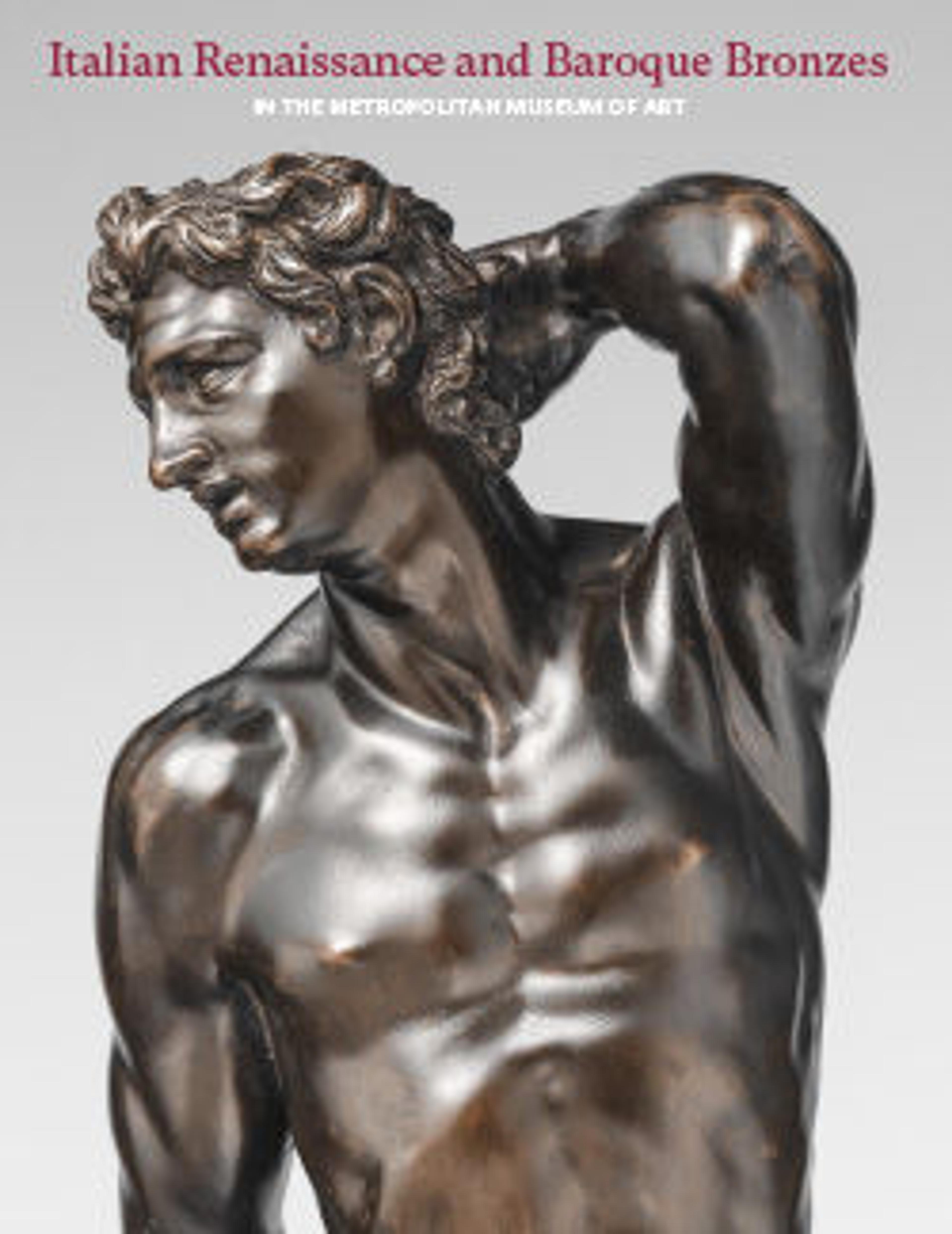Bust of a Roman
The anxious expression, bulging eyes, and cropped hair suggest emulation of Roman portraiture of the Julio-Claudian age.[1] The bust, an unchased indirect cast, exhibits mold cracks and bubble marks from casting in plaster, which suggests a northern Italian origin. Northern Italy certainly produced classicizing busts, but here the imitation of Republican style is so sedulously archaeological as to suggest a much later date, and the extremely thin casting implies the hand of a silversmith regardless of date or place.[2] A distinctly superior version, with pronounced, high cheekbones, is in the Galleria Estense, Modena (fig. 28a).[3] It is no doubt the original, its slightly larger size proving that ours is a shrunken after-cast of it. In Modena, it is paired with a bust of a woman in braids, apparently the one cited in the 1584 inventory of Alfonso II d’Este, duke of Ferrara. Currently, both are improbably assigned to Nicolò Roccatagliata.[4]
A charming feature of the present work, absent from the Modena bronze, is the integrally cast scrolling floral volute on the back (fig. 28b). It once formed the top of a prong or strap that anchored the bust to the rear of its lost original base. The Modena bust has better-formed irises against the stained-bone whites of the eyes and a crisper rendering of the feathered locks, particularly noticeable at the crown of the head. In our bust, by contrast, these areas are mere blurs.
-JDD
Footnotes
(For key to shortened references see bibliography in Allen, Italian Renaissance and Baroque Bronzes in The Metropolitan Museum of Art. NY: The Metropolitan Museum of Art, 2022.)
1. Compare, for example, ancient portraits sometimes discussed in relation to Brutus, such as a male bust in The Met, 14.40.696; see Picón et al. 2007, no. 381. The Augustan age also produced miniature bronze busts that could have inspired ours, for example, Kunsthistorisches Museum, VI 273.
2. R. Stone/TR, October 13, 2011.
3. Bode 1907–12, vol. 2, pl. CVII (as after the antique); Planiscig 1930, pl. 103 (as North Italian, 16th century, height mistakenly given as 12 cm); Salvini 1955, p. 41 (as North Italian, late 15th century); Franzoni 1982–83, p. 331, figs. 6, 7 (as Julius Caesar, discussed with a dissimilar self-portrait by Giulio della Torre [1481–ca. 1557], active in Verona and Padua, belonging to the Fondazione Miniscalchi Erizzo, Verona).
4. Information supplied by Annunziata Lanzetta. The female bust, with tiny shoulders, originally had glass eyes and a glass or enamel brooch and has a fifteenth-century appearance.
A charming feature of the present work, absent from the Modena bronze, is the integrally cast scrolling floral volute on the back (fig. 28b). It once formed the top of a prong or strap that anchored the bust to the rear of its lost original base. The Modena bust has better-formed irises against the stained-bone whites of the eyes and a crisper rendering of the feathered locks, particularly noticeable at the crown of the head. In our bust, by contrast, these areas are mere blurs.
-JDD
Footnotes
(For key to shortened references see bibliography in Allen, Italian Renaissance and Baroque Bronzes in The Metropolitan Museum of Art. NY: The Metropolitan Museum of Art, 2022.)
1. Compare, for example, ancient portraits sometimes discussed in relation to Brutus, such as a male bust in The Met, 14.40.696; see Picón et al. 2007, no. 381. The Augustan age also produced miniature bronze busts that could have inspired ours, for example, Kunsthistorisches Museum, VI 273.
2. R. Stone/TR, October 13, 2011.
3. Bode 1907–12, vol. 2, pl. CVII (as after the antique); Planiscig 1930, pl. 103 (as North Italian, 16th century, height mistakenly given as 12 cm); Salvini 1955, p. 41 (as North Italian, late 15th century); Franzoni 1982–83, p. 331, figs. 6, 7 (as Julius Caesar, discussed with a dissimilar self-portrait by Giulio della Torre [1481–ca. 1557], active in Verona and Padua, belonging to the Fondazione Miniscalchi Erizzo, Verona).
4. Information supplied by Annunziata Lanzetta. The female bust, with tiny shoulders, originally had glass eyes and a glass or enamel brooch and has a fifteenth-century appearance.
Artwork Details
- Title:Bust of a Roman
- Date:possibly 16th century
- Culture:Northern Italian
- Medium:Bronze, on a later wood socle
- Dimensions:Overall (confirmed): 7 5/8 × 4 1/2 × 4 in. (19.4 × 11.4 × 10.2 cm)
- Classification:Sculpture-Bronze
- Credit Line:Rogers Fund, 1927
- Object Number:27.14.14
- Curatorial Department: European Sculpture and Decorative Arts
More Artwork
Research Resources
The Met provides unparalleled resources for research and welcomes an international community of students and scholars. The Met's Open Access API is where creators and researchers can connect to the The Met collection. Open Access data and public domain images are available for unrestricted commercial and noncommercial use without permission or fee.
To request images under copyright and other restrictions, please use this Image Request form.
Feedback
We continue to research and examine historical and cultural context for objects in The Met collection. If you have comments or questions about this object record, please contact us using the form below. The Museum looks forward to receiving your comments.
